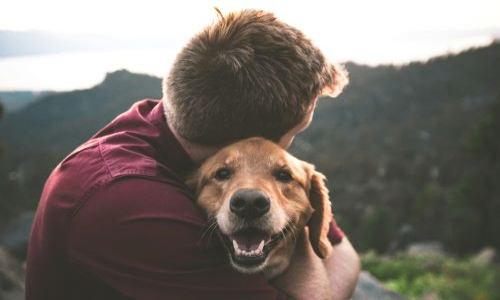A Veteran's Best Friend: The Impact of Assistance Dogs
Assistance dogs for veterans are much more than pets; they are highly trained four-legged companions that provide essential support to many veterans, particularly those struggling with PTSD. These incredible assistance dogs play a crucial role in improving the lives of veterans by offering assistance and companionship tailored to the unique needs of each individual. Assistance dogs for veterans are specially trained to perform a variety of tasks that help their handlers navigate daily life with more ease and independence. For veterans with PTSD, these dogs can provide emotional support, help alleviate anxiety and panic attacks, and interrupt harmful behaviours or thoughts. They can also help veterans by guiding them to safe spaces, and even alert them to potential dangers.
One of the key benefits of having an assistance dog for veterans is the companionship and unconditional love they provide. Many veterans struggling with PTSD may feel isolated or disconnected from others, but an assistance dog can offer constant companionship and a sense of security. The bond between a veteran and their assistance dog is often incredibly strong and can be a source of comfort during difficult times.
Additionally, assistance dogs can help veterans reintegrate into civilian life by providing a sense of routine and purpose. By caring for their dog and meeting their needs, veterans can regain a sense of responsibility and structure in their daily lives. This can be particularly beneficial for veterans transitioning out of the military or adjusting to civilian life after deployment.
Assistance dogs for veterans play a critical role in improving the mental health and well-being of those who have served our country. Through their training, companionship, and support, these remarkable animals provide a lifeline for veterans struggling with the impacts of their service.
What are Assistance Dogs for Veterans?
Assistance dogs for veterans are specially trained to offer various forms of aid and support to their handlers. These dogs undergo rigorous training to learn how to assist individuals with physical disabilities, sensory impairments, and psychological conditions like PTSD.
These dogs can provide physical assistance by helping with tasks such as retrieving items, opening doors, turning lights on and off, and providing stability for individuals with mobility issues. They can also offer emotional support by sensing signs of anxiety or distress and providing comfort to their handlers.
Assistance dogs for veterans can also help individuals with PTSD by providing a sense of security, interrupting flashbacks, or nightmares, and offering companionship during challenging times. These dogs can greatly improve the quality of life for veterans who may be struggling with the effects of their service.
How are Assistance Dogs Trained to Help Veterans?
Assistance dogs undergo specialised training programmes that teach them a wide range of tasks to assist veterans. These programmes often include obedience training, socialisation exercises, and task-specific training to ensure that the dogs are fully prepared to support their handlers in various situations. Some of the specific tasks that assistance dogs may be trained to perform for veterans include:
- PTSD support: Assistance dogs can provide emotional support and help veterans with PTSD by interrupting anxiety attacks, providing comfort during stressful situations, and offering a sense of security and companionship.
- Retrieving items: Dogs can be trained to retrieve items such as medication, phones, or keys for veterans who may have difficulty bending down or reaching certain objects.
- Providing physical contact: Dogs can offer physical contact through activities such as leaning against their handler, providing deep pressure stimulation, or resting their head on their handler's lap to offer comfort and calming support.
Training programmes typically involve exposure to various public settings, as well as simulating real-life scenarios to ensure that the dogs are comfortable and capable of assisting their handlers in all situations. Additionally, trainers work closely with veterans to understand their specific needs and tailor the training programme to meet those needs. After completing their training, assistance dogs are paired with veterans based on compatibility and individual needs, forming a strong bond that enhances their partnership and support.
What Tasks Can Assistance Dogs Perform for Veterans?
Assistance dogs can perform a variety of tasks for veterans, including alerting them to signs of anxiety or stress, retrieving items, providing physical support, and offering emotional comfort during challenging times. Some specific tasks that assistance dogs can perform for veterans may include:
- Alerting the veteran to signs of a panic attack or PTSD episode before it occurs, allowing the veteran to take necessary steps to manage their symptoms.
- Retrieving items or bringing items such as medication to the veteran as needed.
- Providing physical support by guiding the veteran through crowded or unfamiliar environments.
- Waking the veteran from nightmares or disrupting flashbacks by applying pressure or offering comfort.
- Providing a sense of security and companionship, reducing feelings of loneliness and isolation.
- Assisting with daily tasks such as opening doors, turning on lights, or fetching medication.
- Offering emotional support and a non-judgmental presence for the veteran to confide in and lean on during challenging times.
- Supporting the veteran in developing routines and coping strategies for managing symptoms of anxiety, depression, or PTSD.
- Acting as a bridge to social interaction by providing a conversation starter and helping the veteran feel more comfortable in social settings.
Assistance dogs can play a crucial role in enhancing the well-being and quality of life for veterans by providing practical assistance, emotional support, and companionship.
What Benefits Do Assistance Dogs Provide for Veterans with PTSD?
For veterans battling PTSD, assistance dogs offer invaluable support by helping to reduce anxiety, providing a sense of security, and serving as loyal companions who are always there to offer comfort and reassurance.
Assistance dogs can truly be invaluable companions for veterans, helping them navigate daily life and cope with the challenges that may arise as a result of their military service.
How Do Assistance Dogs Help Veterans with PTSD?
Assistance dogs play a crucial role in helping veterans manage their PTSD symptoms and navigate the challenges of everyday life after returning from service. These canine companions offer crucial emotional support and assistance that can make a significant difference in the lives of veterans. Assistance dogs can provide a sense of companionship and comfort to veterans struggling with PTSD. Their presence alone can help reduce feelings of loneliness and isolation, which are common symptoms of the disorder. Dogs have a calming effect on individuals, and their unconditional love and loyalty can provide veterans with a sense of security and emotional support.
One of the main ways that assistance dogs help veterans with PTSD is by providing them with a sense of routine and structure. Dogs need to be fed, exercised, and cared for on a daily basis, which can help veterans establish a routine and focus on responsibilities outside of their PTSD symptoms. This can be particularly beneficial for veterans who may have difficulty adjusting to civilian life or feel overwhelmed by everyday tasks.
Assistance dogs are also trained to provide specific tasks that can help veterans manage their symptoms. For example, dogs can be trained to wake up their owners if they are experiencing nightmares or flashbacks during the night. They can also assist with physical tasks such as retrieving medication. These tasks not only provide practical assistance but also help veterans feel more supported and less alone in dealing with their symptoms.
In addition to these practical benefits, assistance dogs can also help veterans improve their overall mood and well-being. Spending time with a dog has been shown to reduce stress, anxiety, and depression, all of which are common symptoms of PTSD. The act of caring for a dog can also help veterans feel a sense of purpose and accomplishment, which can be especially important for individuals struggling with mental health issues.
Assistance dogs play a vital role in helping veterans with PTSD manage their symptoms, improve their quality of life, and navigate the challenges of post-service life. Through their unconditional love, support, and practical assistance, these canine companions provide valuable aid to veterans in need.
Can Assistance Dogs Detect Signs of Anxiety in Veterans?
Assistance dogs are known for their remarkable ability to detect changes in their handler's mood and behaviour. They can alert veterans to signs of anxiety or distress, providing them with an opportunity to employ coping strategies or seek support. Studies have shown that assistance dogs can be trained to notice signs of anxiety in their handlers, such as increased heart rate, trembling, or shallow breathing. They can then provide comfort and support to help the veteran manage their anxiety symptoms. Additionally, assistance dogs can be trained to perform specific tasks to help their handlers cope with anxiety, such as interrupting repetitive or anxious behaviours, providing deep pressure therapy, or guiding their handlers to a safe place.
Having a trained assistance dog by their side can be incredibly beneficial for veterans with anxiety, as the dog can provide a sense of security and companionship. The presence of an assistance dog can also help reduce feelings of loneliness and isolation, which are common amongst veterans experiencing anxiety.
Assistance dogs play a valuable role in supporting veterans with anxiety and other mental health challenges. Their ability to detect and respond to signs of anxiety can help veterans feel more confident and in control of their symptoms, ultimately improving their overall well-being and quality of life.
How Do Assistance Dogs Provide Emotional Support to Veterans?
Assistance dogs offer unwavering emotional support to veterans by offering companionship, unconditional love, and a non-judgmental presence. These four-legged friends can help veterans feel less isolated and provide a sense of connection and understanding. Assistance dogs also provide a calming presence and can help alleviate symptoms of anxiety and stress in veterans. These dogs are trained to sense emotional distress and offer comfort and reassurance to their handlers.
Assistance dogs can help veterans feel more secure and confident in social situations. These dogs can help veterans navigate crowded spaces and interact with others, serving as a buffer and source of support during challenging situations.
Assistance dogs play a crucial role in providing emotional support to veterans by offering companionship, comfort, and a sense of security. Their unconditional love and unwavering loyalty can make a significant difference in the lives of veterans struggling with emotional challenges.
What Role Do Assistance Dogs Play in the Recovery Process for Veterans with PTSD?
Assistance dogs play a vital role in the recovery process for veterans with PTSD by offering a constant source of support, comfort, and companionship. They are instrumental in helping veterans navigate their emotional challenges and build resilience as they work towards healing and recovery. Assistance dogs can provide a sense of security and safety for veterans with PTSD by alerting them to potential triggers or signs of distress. These dogs are trained to recognise signs of anxiety and panic attacks and can help intervene by providing comfort and grounding techniques to help the veteran return to a calmer state.
The presence of an assistance dog can help reduce feelings of isolation and loneliness that many veterans with PTSD may experience. Dogs are known for their unconditional love and loyalty, which can provide veterans with a sense of purpose and companionship as they navigate their recovery journey. Having a dog by their side can also encourage veterans to engage in social activities, exercise, and outdoor adventures that can be beneficial for their mental and physical well-being.
What Is the Training Process Like for Veterans and Their New Assistance Dogs?
The training process for veterans and their new assistance dogs involves learning how to effectively communicate, work together, and address the unique needs of the veteran. This training helps establish a strong bond between the two and equips them to navigate various situations with confidence. The training typically begins with an initial meet and greet between the veteran and their new assistance dog, allowing them to get to know each other and start building trust. From there, the training process may include:
- Basic obedience training: Both the veteran and the dog will receive basic obedience training to ensure they can communicate effectively and work together as a team.
- Task-specific training: Depending on the needs of the veteran, the assistance dog will be trained to perform specific tasks such as opening doors, retrieving items, providing stability and balance, alerting to medical issues, and more.
- Public access training: Assistance dogs must be well-behaved and able to accompany their veteran handler in public places. Training may include desensitisation to various environments, learning proper behaviour in public, and practising tasks in real-world settings.
- Bonding activities: Building a strong bond between the veteran and their assistance dog is crucial for a successful partnership. Activities such as play, grooming, and relaxation time together help strengthen this bond.
- Continued support: Training doesn't end once the team is matched. Ongoing support and follow-up training are often provided to ensure the successful integration of the assistance dog into the veteran's daily life.
The training process is designed to empower veterans to live more independently and confidently with the support of their assistance dogs. It is a collaborative effort that requires dedication, patience, and a willingness to work together as a team.
Why Are Assistance Dogs Considered Heroes to Veterans?
Assistance dogs are considered heroes to veterans for their unwavering dedication, loyalty, and the invaluable support they provide. These four-legged companions symbolise solace and support, serving as trusted allies to veterans as they navigate the challenges of post-service life. Assistance dogs are trained to provide a range of services to veterans, including guiding blind veterans, alerting deaf veterans to sounds, retrieving items, and providing physical support for veterans with mobility issues. These dogs are also trained to provide emotional support, offering comfort and companionship to veterans struggling with mental health issues such as post-traumatic stress disorder (PTSD) or anxiety.
The bond between a veteran and their assistance dog is incredibly strong, with the dog often becoming a constant source of comfort and stability in the veteran's life. Assistance dogs are always by their veteran's side, offering unconditional love and support, which can be particularly important for veterans who may feel isolated or disconnected from society.
Assistance dogs also help veterans regain a sense of independence and confidence, as they provide assistance with daily tasks and help veterans navigate their surroundings more easily. This level of support can be life-changing for veterans, allowing them to live more fulfilling and independent lives.
How Do Assistance Dogs Symbolise Solace and Support for Veterans?
Assistance dogs symbolise solace and support for veterans by offering unconditional love, emotional comfort, and a sense of security. Their presence serves as a constant source of reassurance and companionship, helping veterans feel less alone and more understood. Additionally, assistance dogs can provide practical help with tasks such as retrieving items, opening doors, and navigating crowded spaces, making daily life easier and more manageable for veterans with physical disabilities or mobility issues. This support can give veterans a sense of independence and freedom that they may have lost after leaving the military.
Furthermore, the bond that forms between a veteran and their assistance dog is built on trust, loyalty, and mutual understanding. This connection can be deeply healing for veterans struggling with PTSD, anxiety, or other mental health challenges, as the dog provides a non-judgmental and calming presence that can help them cope with their symptoms and feel more grounded.
Assistance dogs serve as a powerful symbol of solace and support for veterans, offering them not only practical assistance but also emotional comfort, companionship, and a sense of purpose. Through their presence and unwavering devotion, these dogs remind veterans that they are not alone in their struggles and that they deserve love and care in their journey towards healing and recovery.
What Impact Do Assistance Dogs Have on the Mental Health of Veterans?
Assistance dogs have a profound impact on the mental health of veterans by providing emotional support, companionship, and a sense of purpose. These loyal companions help veterans manage their PTSD symptoms, reduce feelings of isolation, and improve overall well-being. Studies have shown that assistance dogs can help veterans cope with anxiety and depression by providing constant companionship and a sense of security. The unconditional love and non-judgmental nature of assistance dogs can help veterans feel less alone and more connected to the world around them.
Assistance dogs are also trained to detect and respond to their handler's emotional distress, which can help veterans better manage their PTSD symptoms. For example, a dog may be trained to provide physical comfort during a panic attack or wake their handler from a nightmare. This can help veterans feel more in control of their emotions and reduce the severity of their symptoms.
In addition to providing emotional support, assistance dogs can also help veterans establish a routine and sense of purpose. Caring for a dog requires daily exercise, training, and attention, which can help veterans stay active and engaged in daily life. Having a dog to care for can also give veterans a sense of responsibility and motivation to stay healthy and focused on their recovery.
Assistance dogs play a crucial role in supporting the mental health of veterans by providing companionship, emotional support, and a sense of purpose. These incredible animals help veterans feel connected, supported, and empowered to live their lives to the fullest.
What Should Veterans Know Before Acquiring an Assistance Dog?
Before adopting an assistance dog, veterans should be aware of the responsibilities involved in caring for their canine companion. Establishing a successful bond with the assistance dog requires commitment, time, and a willingness to prioritise the dog's well-being alongside their own. Veterans should also be prepared for the financial costs associated with owning an assistance dog, including veterinary care, grooming, food, and any necessary training or equipment. They should also be aware that assistance dogs require regular exercise, mental stimulation, and socialisation to maintain their health and well-being.
Veterans should thoroughly research different assistance dog organisations and programmes to find the right fit for their needs and lifestyle. It's important to consider the specific tasks the assistance dog is trained to perform and how those tasks will benefit the veteran in their daily life.
Veterans should also be prepared for the time and effort required to train with their assistance dog and build a strong bond. Consistent training and communication are key to fostering a successful partnership between the veteran and their canine companion.
Veterans should be aware of the legal rights and responsibilities that come with owning an assistance dog, including access to public places and housing accommodation. It's important to educate oneself on the laws and regulations regarding service animals to ensure a smooth transition and integration of the assistance dog into their daily life.
What Are the Responsibilities of Veterans in Caring for Their Assistance Dogs?
Veterans are responsible for the well-being and care of their assistance dogs, including meeting their physical, emotional, and medical needs. Regular exercise, proper nutrition, grooming, and veterinary care are essential components of ensuring the dog's health and happiness. Veterans are also responsible for providing a safe and stable environment for their assistance dogs, as well as training and socialising them to ensure they can effectively perform their tasks and adapt to different situations. This includes providing ongoing training and reinforcement to maintain the dog's skills and obedience.
Veterans are responsible for advocating for their assistance dogs and ensuring they have access to necessary resources and accommodations in public spaces, transportation, and housing. This may involve educating others about the role of assistance dogs and their rights under the Equality Act (2010).
Veterans should also be prepared to communicate openly and honestly with their assistance dog's trainers, caregivers, and healthcare providers to address any potential issues or concerns, as well as seek support and guidance as needed. By fulfilling these responsibilities, veterans can cultivate a strong and mutually beneficial partnership with their assistance dogs that enhances their quality of life and independence.
How Can Veterans Ensure a Successful Bond with Their New Assistance Dog?
Veterans can ensure a successful bond with their new assistance dog by investing time in training, communication, and positive reinforcement. Building trust, establishing routines, and fostering mutual respect are key elements in developing a strong and lasting bond between the veteran and their canine companion.
Veterans must also provide consistent and effective training to their assistance dogs to ensure they are able to perform their tasks and duties effectively. This includes ongoing obedience training, socialisation, and reinforcement of desired behaviours.
Additionally, veterans are responsible for providing a safe and comfortable living environment for their assistance dogs, including appropriate shelter, access to clean water, and a comfortable bed or resting area.
Veterans must also be aware of their assistance dog's limitations and needs, respecting their physical and emotional boundaries. It is important for veterans to communicate appropriately with their assistance dogs and be attuned to their needs and preferences.
People have a responsibility to treat their assistance dogs with love, respect, and compassion, recognising the important role these animals play in their lives. By fulfilling these responsibilities, veterans can ensure a strong and lasting bond with their assistance dogs and maximise the benefits of having them as companions and helpers.








